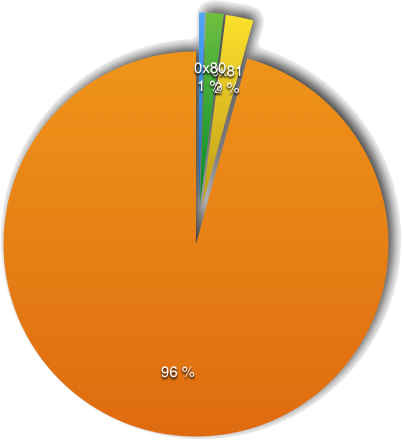ATR statistics: TA2 - Global, specific mode byte
Article from the series "ATR statistics"
TA2 - Global, specific mode byte
The ISO 7816-3 specification is not public. So I can't copy/paste part of the text. I will use Wikipedia instead.From Wikipedia https://en.wikipedia.org/wiki/Answer_to_reset#Interface_byte_TA2
Interface byte TA2, if present, is global, and is named the specific mode byte.
Presence of TA2 commands that the reader use specific mode as defined by TA2 and earlier global bytes, rather than negotiable mode when TA2 is absent.
TA2 encodes in its 4 low-order bits an integer T defining the protocol required by the card, in the convention used for TD1 (EMV prescribes that a card which T encoded in TA2 does not match that in TD1 shall be rejected).
The 5th bit is 0 to encodes that the required ETU duration is Fi/Di clock cycles as defined by TA1 (or its default value if absent); or 1 to indicate that the ETU duration is implicitly known (by some convention, or setting of the reader; EMV prescribes that such card shall be rejected).
The 6th and 7th bit are reserved for future use; 0 indicates not used.
The 8th bit is 1 to indicate that the card is unable to change the negotiable/specific mode (that is, does not propose other settings); or 0 to indicate that card has that ability (perhaps after a warm ATR).
Historical note: Provision for specific mode did not exist in ISO/IEC 7816-3:1989. Back then, the interface character TA2 had no particular name or function, and was specific (to the protocol introduced by TD1). ISO/IEC 7816-3:1997 introduced the specific mode and the specific mode byte, with interim note helping cards with specific mode byte TA2 in their ATR dealing with a reader that did not implement specific mode.
| TA2 | # | % |
|---|---|---|
| 1983 | 95.70 % | |
| 0x81 | 48 | 2.32 % |
| 0x80 | 31 | 1.50 % |
| 0x00 | 10 | 0.48 % |
TA2 is used by only 4.30% of cards. 95.70% of smart cards in my list have no TA2 defined.
- 0x81 indicates "Protocol to be used in spec mode: T=1 - Unable to change - defined by interface bytes".
- The 4 low-order bits are set to 0001b so T=1 protocol.
- The 8th bit set to 1 to indicate unable to change the negotiable/specific mode
- 0x80 indicates "Protocol to be used in spec mode: T=0 - Unable to change - defined by interface bytes"
- The 4 low-order bits are set to 0000b so T=0 protocol.
- The 8th bit set to 1 to indicate unable to change the negotiable/specific mode
- 0x00 indicates "Protocol to be used in spec mode: T=0 - Capable to change - defined by interface bytes"
- The 4 low-order bits are set to 0000b so T=0 protocol.
- The 8th bit set to 0 to indicate the card is able to change the negotiable/specific mode
